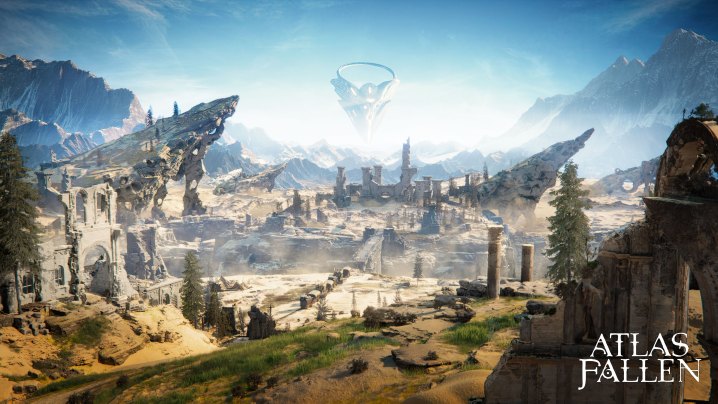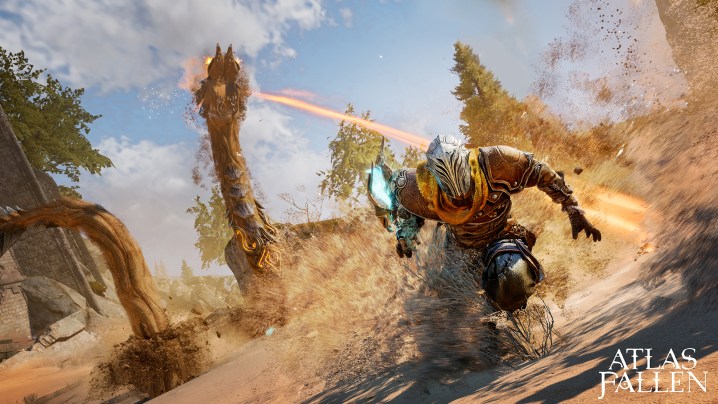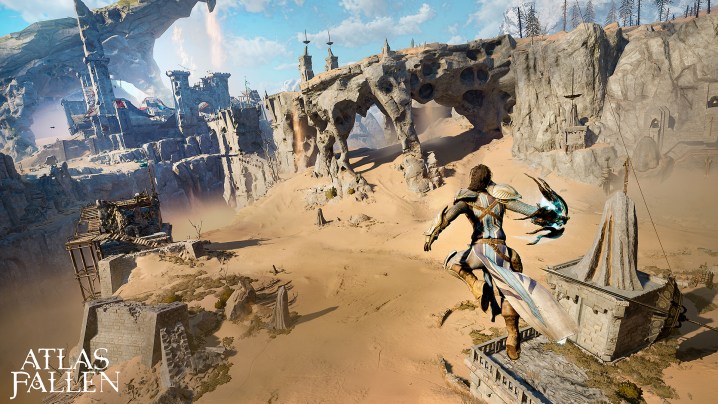“Atlas Fallen has some ambitious ideas for a game of its scale, but its poor presentation holds back a promising combat system.”
- Fun sand-surfing
- Satisfying traversal
- Thoughtful Momentum combat
- Weak opening
- Bad voice acting
- Lackluster visuals
- Technical problems
First impressions mean a lot, and Atlas Fallen doesn’t exactly put its best foot forward.
Atlas Fallen is an ambitious AA fantasy open-world game with satisfying sand-surfing movement and combat enhanced by a dynamic momentum system, but developer Deck13 does not lead with any of that. Instead, my first hour with Atlas Fallen was a drag as I made my way through a slow linear opening in which my custom character finds a gauntlet with the power of a god and escapes captivity.
The poor voice acting and visuals of Atlas Fallen were on clear display during that time as I explored a dreary camp at night, trying to get support to revolt against the evil Captain enslaving us all. Lots of worldbuilding and jargon about gods, nights, the world’s social system, and more were laid on me in rapid succession before I ever had a chance to get invested in anything the game had to say. It’s a weak opening and an omen of what was to come. Atlas Fallen is an ambitious game, but one that struggles to live up to that ambition consistently.
An intriguing story told poorly
In Atlas Fallen, players are fighting back against the good that rules over this dreary, ruined fantasy world with the help of Nyall. Nyall is an amnesiac being with god-like powers whose spirit is intertwined with a gauntlet that grants its user magical abilities. Atlas Fallen’s story is about fighting back against oppression. While that’s a noble central theme, the dryness of the narrative’s delivery, especially in the opening section of the game, made it tough to get that invested in it.
Atlas Fallen’s realistic visuals lag behind contemporary open-world games …
None of that is helped by the fact that Atlas Fallen’s presentation overall is lacking. It features some of the weakest voice acting I’ve heard in a game of this scale in some time, with poor deliveries on lines that aren’t all too well written to begin with. It can sometimes have a so-bad-it’s-good quality because of how earnestly Atlas Fallen presents itself. However, it makes those early hours extremely tough to get through, turning a potentially intriguing narrative into a low point.
Atlas Fallen’s realistic visuals lag behind contemporary open-world games, and the dry conversations that dominate the game’s early hours look stilted with rough facial and character animation. Even later on, as sand-surfing takes center stage, and sand effects don’t look that impressive. I was certainly disappointed the first time I started surfing around, only for it the effect to look blurry and for any marking left behind me in the sand to disappear quickly. In rejecting a more stylized approach akin to a game like Journey, we’re left with a stilted realism that looks dated.

Satisfying sand-surfing
While the opening of Atlas Fallen is disappointingly linear, it’s not emblematic of most of the game. What I did most of the time was sand-surf from mission to mission in the open world, obtaining items for fetch quests or fighting a group of enemies to progress the story. While sand surfing lacks much of a visual impact, Atlas Fallen’s movement is satisfying. It feels closest to Forspoken as players can sand-surf, jump, and air dash across large open-world areas. The ability to raise structures sunken item the sand is an exciting touch, although its use is largely contextual.
Fluid movement is a core component of great open-world games, and Atlas Fallen has that. After beating it, I spent some time just jumping and moving around the (literal) sandbox. Sadly, the map design doesn’t do a lot to back that solid movement up, as the only memorable area from my adventure was a sunken city where I could fight a boss in a Colosseum. There are some egregious pop-in issues too, which hurt my sense of speed as the game tore apart at its seams, unable to keep up with me.

It took a couple of hours before movement options opened up and objectives became non-linear enough that I could truly get a feel for one of the strongest parts of the game. It’s another way that Atlas Fallen’s weak opening ultimately misleads more than it immerses. Atlas Fallen becomes a more enjoyable adventure once more movement tools are unlocked, but there’s a lot of quicksand to trudge through to get to that point.
Keeping up the momentum
The core of Atlas Fallen’s combat is comparable to contemporary action games as it emphasizes swift light and heavy attacks between dodging and parrying. Some rough animations can make timing those defensive moves challenging, but it’s an easily understandable loop that action game fans should be able to pick up with relative ease. That’s what makes the Momentum system — which intends to add a lot more risk-versus-reward decisions to every combat encounter — so intriguing.
I engaged with Atlas Fallen‘s combat on a deeper level, taking more risks than I normally like to in tough action games.
Alongside my health bar, there’s a blue momentum bar split into three sections and slowly fills with each blow I deal an enemy. The more I fill it, the more abilities I had at my disposal during a battle. The catch? The damage I take from enemies increases as the bar fills. The only way to regain the energy needed to heal is by attacking enemies, like in Marvel’s Spider-Man: Miles Morales, which is another way the game encourages players to stay on the offensive for as long as possible.
At first, I tried to play Atlas Fallen conservatively, only hitting the enemy as much as I needed to before a heal. The more I played, though, the more beneficial it was to maintain high momentum. After at least a third of a momentum bar is full, players can pull off a powerful “Shatter” attack at any time to interrupt what the enemy is doing and deal massive damage. This led to some intense encounters against tougher foes; I remember being quite disappointed in myself when I died in the last part of the final boss fight because I allowed myself to take too much damage with high momentum.

The main reward for combat encounters is Essence Stones. These, which are crafted with materials found throughout Atlas Fallen’s main areas, add abilities as players gain momentum across all three tiers. For each tier, players can have a loadout of one active skill, which adds a new attack to the player’s arsenal at that tier, and three passive skills, which give passive buffs or assistance during combat. I ended up equipping myself with a very offensive build that gave me lots of attack buffs and more generous parrying windows, making it significantly easier to build momentum. This yielded immediate results, highlighting the true strength of the standout Momentum system. Because I had the power to tailor my character to my liking, I engaged with Atlas Fallen‘s combat on a deeper level, taking more risks than I normally like to in tough action games.
Ambition vs. reality
Despite the limits of Atlas Fallen’s presentation, I found that Deck13’s creativity did make the adventure a little more endearing. A lot of its boldest swings simply don’t land, though. Even within the eight hours it took me to beat the game while completing some side-quests along the way, the game’s aspirations always felt more extensive than the scope its developers could achieve. Momentum adds an invigorating risk-versus-reward system into combat but loses its luster as combat encounters keep happening against the same enemies and get increasingly repetitive as they play out the same way every time.

Fluid movement is held back by lackluster visuals, tech issues, and a lack of engaging mission or world design that pulls me out of the experience whenever I’m not just turning my brain off and enjoying traversal. And though Atlas Fallen’s story deals with intriguing themes in a creative, original world, that’s never delivered in a way that feels engrossing or polished.
Within an hour of playing Atlas Fallen, the game’s strengths and weaknesses all become clear. It’s a smaller release punching above its weight class. That’s endearing, but ambition only gets you so far. Though even when a game disappoints like Atlas Fallen, you can still often excavate some innovative ideas from them. I just had to do a lot of sifting in order to find the gold in a sand sea of other issues.
Atlas Fallen was reviewed on Xbox Series X.




